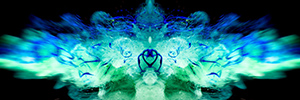- Future Students
- Current Students
- Faculty
- Staff
- Alumni
- Others
The changing face of face processing

There are so many people around the world looking at face processing to understand how we recognize faces.
Why do we recognize the faces of friends, loved ones or even celebrities even in vastly different environments and viewing conditions, or despite changes to their appearance? Why do we tend to struggle to verify the identity of strangers even when we can look at multiple photographs?
Questions like these have long interested University of Guelph-Humber Psychology Assistant Program Head Dr. Adam Sandford. He recently published a chapter in Dr. Markus Bindemann and Dr. Ahmed M. Megreya’s book Face Processing: Systems, Disorders and Cultural Differences. Dr. Sandford’s chapter, titled “Configural Processing and the Recognition of Familiar Faces,” takes a comprehensive and critical look at the recent published literature on configural processing of faces.
It’s a research field that is growing at a rapid pace, and reviewing recent studies provided a fascinating indication to Dr. Sandford of where face processing is now and where it could be headed in the future.
“There are so many people around the world looking at face processing to understand how we recognize faces. The book is a collection of work completed by my colleagues with the aim of providing an updated review of the literature, following books in this area of psychology published in 2010, 2011, and 2012,” Dr. Sandford explained.
Recent literature suggests that as we become familiar with a person’s face, the surface properties have a more important role.

Much of the research Dr. Sandford explored deals with “configural processing,” or the process by which people remember other faces not simply by their features, but the distance between those features. In other words, we see someone’s face and remember it based on the distance between their eyes, nose and mouth, then recall that information each time we see each other.
The research Dr. Sandford reviewed, however, in some cases challenged those traditional definitions of configural processing.
For instance, turning a photograph upside-down has been found to significantly impair recognition, even though the configural processing distances are unchanged.
Another research study Dr. Sandford conducted presented participants with pictures of both familiar and unfamiliar people that had been stretched or distorted in some way. The participants were asked to restore the photos to their original aspect ratios. A configural processing account of face recognition would predict more accurate performance with familiar faces in this task compared with unfamiliar faces. Surprisingly, this was not evidenced in the results, as there was no familiarity advantage in restoring the photos. Dr. Sandford included this study as a challenge to traditional notions of configural processing.
Dr. Sandford’s chapter finally suggested that researchers should continue to distinguish between shape and surface properties when looking at face processing. Surface properties include elements like texture and pigmentation.
“It’s this relative shift between the two types of properties,” explained Dr. Sandford, who was recently made Chair-elect of the Brain and Cognitive Sciences section of the Canadian Psychological Association. “Recent literature suggests that as we become familiar with a person’s face, the surface properties have a more important role.
“So I end the chapter with a mention of where we should perhaps be heading, and that the definitions of configural processing may need to be updated.”







